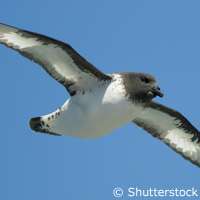Moon cycles and petrels... migration and mating

Creatures on Earth have annual cycles consisting of life history stages of breeding, moult and migration. For some, moon cycles influence their periodic behavior, particularly in the case of birds. New research from Université de La Réunion on Réunion, France probed the influence of photoperiod and moon phases on the migration dates and at-sea activity of Barau's petrel, a tropical seabird species, throughout its annual cycle. The study was published in the journal PLoS ONE.
A monogamous bird species, Barau's petrels (Pterodroma baraui) travel to mating sites on Ile de La Réunion to mate, synchronising their journeys with the full moon. 'First arrival at the colony is crucial in the mating system of colonial animals like seabirds,' says Patrick Pinet of Université de La Réunion, the lead author of the paper.
Contrary to some birds, which use either the Sun or length of the day to migrate and mate, Barau's petrel migrates longitudinally, along the equator. 'This species makes longitudinal migrations although most seabirds perform latitudinal migrations. It thus remains in the tropical zone with slight photoperiodic variations during its whole life cycle. Barau's petrel represents therefore a relevant model to study the relationships between photoperiod and the behaviour of tropical seabird species,' the authors write.
The researchers selected Barau's petrel because it exhibits a predictable annual timing of breeding and migration. These birds are more active when the full moon is out, spending more than three quarters of their time in flight rather than on the water. The researchers postulate that the increase in activity is triggered by their need to hunt for prey, something that is easier for them to do when moonlight is available.
"For the first time, bio-loggers were used to record daily the photoperiod perceived by a free-living migrant bird to study the influence of annual changes in day length on their behavior," the authors write. "The at-sea activity and migration of Barau's petrels were strongly correlated to photoperiod, suggesting a clear proximal control of these behaviours by the duration of daylight. Firstly, the annual activity of birds exhibited seasonal changes in activity according to their annual cycle with a lower proportion of time on water during the breeding compared to the non-breeding stage. The increase in ecological constraints from a growing chick across the breeding season, as regular returns to the colony and higher energetic demands, may explain the higher flight activity during this period. Secondly, migration dates of Barau's petrels were consistent between years and seem to be linked to photoperiod."
The team says the novel use of data loggers offers researchers the chance to study bird behavior under natural conditions. "Currently, many species are tracked around the world and cross-taxa studies could be very useful to investigate the influence of environmental cues on some fascinating behavioural decisions undertaken by free-living organisms."
More information: Pinet, P. et al. (2011) 'Celestial Moderation of Tropical Seabird Behavior. PLoS ONE, published 14 November. DOI:10.1371/journal.pone.0027663
Journal information: PLoS ONE
Provided by CORDIS




















